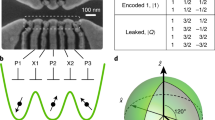Abstract
Various physical implementations of quantum computers are being investigated, although the requirements1 that must be met to make such devices a reality in the laboratory at present involve capabilities well beyond the state of the art. Recent solid-state approaches have used quantum dots2, donor-atom nuclear spins3 or electron spins4; in these architectures, the basic two-qubit quantum gate is generated by a tunable exchange interaction between spins (a Heisenberg interaction), whereas the one-qubit gates require control over a local magnetic field. Compared to the Heisenberg operation, the one-qubit operations are significantly slower, requiring substantially greater materials and device complexity—potentially contributing to a detrimental increase in the decoherence rate. Here we introduced an explicit scheme in which the Heisenberg interaction alone suffices to implement exactly any quantum computer circuit. This capability comes at a price of a factor of three in additional qubits, and about a factor of ten in additional two-qubit operations. Even at this cost, the ability to eliminate the complexity of one-qubit operations should accelerate progress towards solid-state implementations of quantum computation1.
This is a preview of subscription content, access via your institution
Access options
Subscribe to this journal
Receive 51 print issues and online access
$199.00 per year
only $3.90 per issue
Buy this article
- Purchase on Springer Link
- Instant access to full article PDF
Prices may be subject to local taxes which are calculated during checkout


Similar content being viewed by others
References
DiVincenzo, D. P. The physical implementation of quantum computation. Fortsch. Phys. (special issue; Experimental Proposals for Quantum Computation) (in the press); also as preprint quant-ph/0002077 at 〈http://xxx.lanl.gov〉 (2000).
Loss, D. & DiVincenzo, D. P. Quantum computation with quantum dots. Phys. Rev. A 57, 120– 126 (1998).
Kane, B. E. A silicon-based nuclear-spin quantum computer. Nature 393, 133–137 (1998).
Vrijen, R. et al. Electron-spin-resonance transistors for quantum computing in silicon-germanium heterostructures. Phys. Rev. A 62 , 012306-1 to 012306-10 (2000).
Burkard, G., Loss, D. & DiVincenzo, D. P. Coupled quantum dots as quantum gates. Phys. Rev. B 59, 2070–2078 (1999).
Barenco, A. et al. Elementary gates for quantum computation. Phys. Rev. A 52, 3457–3467 ( 1995).
DiVincenzo, D. P. et al. Quantum computation and spin electronics. In Quantum Mesoscopic Phenomena and Mesoscopic Devices in Microelectronics (eds Kulik, I. O. & Ellialtioglu, R.) (NATO ASI, in the press), also as preprint cond-mat/9911245 at 〈http://xxx.lanl.gov〉 (2000 ).
Bacon, D., Kempe, J., Lidar, D. A. & Whaley, K. B. Universal fault-tolerant computation on decoherence-free subspaces. Phys. Rev. Lett. 85, 1758–1761 (2000).
Viola, L., Knill, E. & Lloyd, S. Dynamical generation of noiseless quantum subsystems. Phys. Rev. Lett. 85, 3520– 3523 (2000).
Kempe, J., Bacon, D., Lidar, D. A. & Whaley, K. B. Theory of decoherence-free fault-tolerant universal quantum computation. Phys. Rev. A (submitted); also as preprint quant-ph/0004064 at 〈http://xxx.lanl.gov〉 (2000).
Zurek, W. H. Environment-induced superselection rules. Phys. Rev. D 26, 1862–1880 (1982).
Palma, G. M., Suominen, K.-A. & Ekert, A. K. Quantum computers and dissipation. Proc. R. Soc. Lond. A 452, 567–584 (1996).
Duan, L.-M. & Guo, G.-C. Reducing decoherence in quantum-computer memory with all quantum bits coupling to the same environment. Phys. Rev. A 57, 737–741 (1998).
Lidar, D. A., Chuang, I. L. & Whaley, K. B. Decoherence-free subspaces for quantum computation. Phys. Rev. Lett. 81, 2594– 2597 (1998).
Zanardi, P. & Rasetti, M. Error avoiding quantum codes. Mod. Phys. Lett. B 11, 1085–1093 (1997).
Knill, E. & Laflamme, R. & Viola, L. Theory of quantum error correction for general noise. Phys. Rev. Lett. 84, 2525– 2528 (2000).
Kitaev, A. Y. Quantum computations: algorithms and error correction. Russ. Math. Surv. 52, 1191–1249 ( 1997).
Nielsen, M. A. & Chuang, I. L. Quantum Computation and Quantum Information Appendix 3 (Cambridge Univ. Press, Cambridge, 2000).
Makhlin, Y. Nonlocal properties of two-qubits gates and mixed states and optimization of quantum computations. Preprint quant-ph/0002045 at 〈http://xxx.lanl.gov〉 (2000).
Preskill, J. in Introduction to Quantum Computation and Information (eds Lo, H.-K., Popescu, S. & Spiller, T.) 213–269 (World Scientific, Singapore, 1998).
Lidar, D. A., Bacon, D. & Whaley, K. B. Concatenating decoherence-free subspaces with quantum error correcting codes. Phys. Rev. Lett. 82, 4556–4559 (1999).
Acknowledgements
We thank P. O. Boykin and B. M. Terhal for discussions. D.P.D., D.B., J.K. and K.B.W. were supported by the National Security Agency and the Advanced Research and Development Activity. D.P.D. also thanks the UCLA DARPA program on spin-resonance transistors for support, and is also grateful for the hospitality of D. Loss at the University of Basel, where much of this work was completed. J.K. also acknowledges support from the US National Science Foundation. G.B. is supported in part by the Swiss National Science Foundation.
Author information
Authors and Affiliations
Corresponding author
Rights and permissions
About this article
Cite this article
DiVincenzo, D., Bacon, D., Kempe, J. et al. Universal quantum computation with the exchange interaction. Nature 408, 339–342 (2000). https://doi.org/10.1038/35042541
Received:
Accepted:
Issue Date:
DOI: https://doi.org/10.1038/35042541
This article is cited by
-
Electron charge qubit with 0.1 millisecond coherence time
Nature Physics (2024)
-
Noisy intermediate-scale quantum computers
Frontiers of Physics (2023)
-
Effect of Dzyaloshinskii–Moriya and Kaplan–Shekhtman–Entin–Wohlman–Aharony Interactions on Thermal Entanglement of Heisenberg XYZ Chains Under External Magnetic Field
Journal of Low Temperature Physics (2023)
-
Universal logic with encoded spin qubits in silicon
Nature (2023)
-
Triplet-radical spin entanglement: potential of molecular materials for high-temperature quantum information processing
NPG Asia Materials (2022)
Comments
By submitting a comment you agree to abide by our Terms and Community Guidelines. If you find something abusive or that does not comply with our terms or guidelines please flag it as inappropriate.



